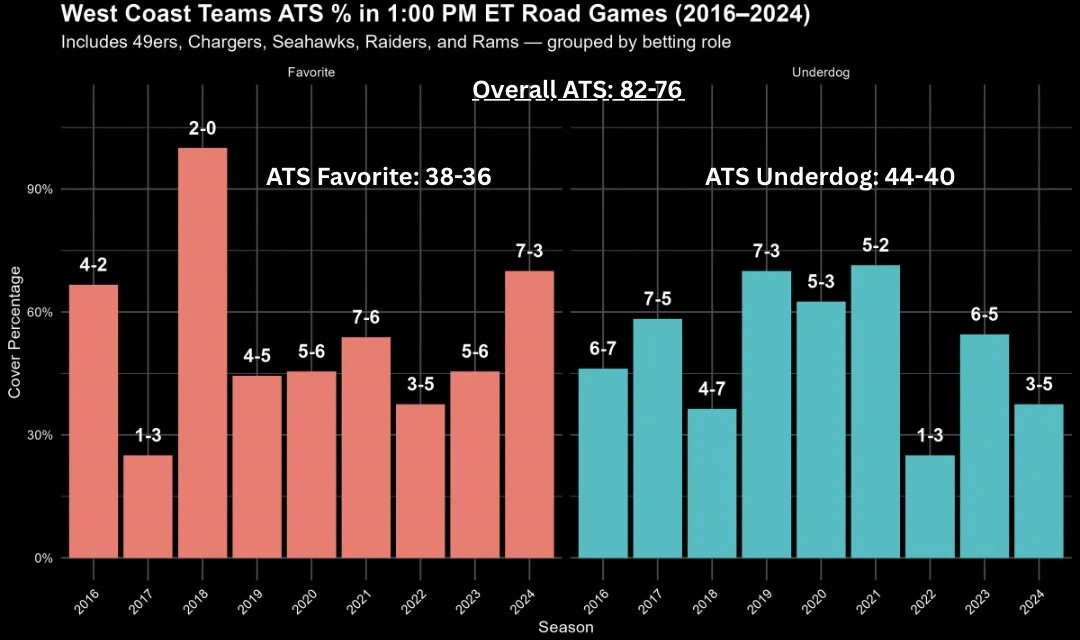RIP: The Trend Of Auto-Fading West Coast Teams Traveling East For Morning Games
One of the most well-known NFL betting theories goes like this: “Always fade West Coast teams playing at 1 PM Eastern.”
But is that smart strategy or just a long-standing myth? Let’s break down what this theory is, where it comes from, and whether betting it still holds up in today’s NFL?
The Logic Behind the Trend
At the heart of this belief is circadian rhythm disruption—the idea that athletes from the West Coast (e.g., the 49ers, Rams, Chargers, Seahawks, Raiders) traveling to the East Coast are forced to play at what feels like 10:00 AM to their internal body clocks.
In theory, this should lead to sluggish starts, reduced mental sharpness, and lower scoring output or early-game deficits. And that’s supposed to make these teams more likely to lose against the spread (ATS), especially when playing a team acclimated to that 1 PM start.
Historical Performance: Was This Ever True?
This belief did hold weight in past decades. Early 2000s betting data showed a notable ATS disadvantage for West Coast teams in early games out East. Bettors who blindly faded those teams often came out ahead—at least for a time.
But like any trend in sports betting, nothing lasts forever.
📉 In recent years, the edge has shrunk dramatically.
Previous data have shown that from 2003 to around 2014, fading West Coast teams in these 1 PM games produced a profitable ATS record.
However, since 2015, that edge has largely flattened. West Coast teams began covering at roughly a 50/50 clip, meaning no real advantage for bettors fading them blindly. We did our own deep dive looking at this exact scenario since 2016 (When the Rams moved from St. Louis to LA) and the results are damning.
Overall, West coast teams in this scenario are 82-76 ATS which means they’ve covered 51.8% of the time. As a reminder, if you’re betting at -110 odds, you need to win 52.4% of the time just to break even. So while blindly fading West coast teams to cover would have lost you money, blindly backing them would also be a losing strategy.
We also broke down the records by if they were a favorite or underdog and we get more of the same. As a favorite, West coast teams are 38-36 (51.3% cover rate) an dogs are 44-40 (52.4% cover rate). Finally, we wanted to make sure these numbers weren’t driven by just one or two really good years. The only year were this trend would have covered would have been 2022 when these teams went 4-8 overall aka a 67% cover rate if you faded every game. I don’t know about you, but a trend that hits once out of 9 years is not one I’m willing to put my money behind.
If you’re thinking “OK, as a group this doesn’t hold but surely it still has value for one of the teams”, I’ve got more bad news. While the Raiders were the worst at 17-21 over this time frame (44.7% cover rate or 55.3% if you faded them), they were also 70-76-4 ATS overall so this had nothing to do with them sucking (No offense Raider Nation!) See slideshow below to see how each team has fared since 2016.





Why the Change?
There are a few key reasons this trend no longer hits like it used to:
Improved Travel Protocols
NFL teams now regularly fly in early (Friday or Saturday), adjust practice times, and control rest cycles more carefully.
Better Sports Science
Teams invest heavily in athlete’s health, nutrition, and cognitive performance to mitigate time zone issues.
Market Correction
Oddsmakers and sharp bettors caught on. Spreads now often bake in any time zone disadvantage, reducing the exploitable edge.
Bottom Line
The “fade West Coast teams at 1 PM” trend was once a profitable angle, but it's no longer a guaranteed edge. And this makes sense. The NFL is all about viewership. Teams getting consistently and predictably blown out is bad for business. If this angle still existed today, you would likely see some changes to reduce these noncompetitive games. The travel/time zone angle is still a factor, but not strong enough on its own to justify an automatic bet.
What you would be better off doing is using data that have been proven to predictive in covering spreads and winning games. At BTB Analytics, that’s exactly what we do with our NFL and CFB models. We give you the best edges for every matchup so you have the best chance of consistently coming out on top because smart betting isn’t about sticking to myths… it’s about outsmarting the market.
If you want to become a member, please see our Member Access page to sign up!



